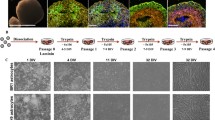Abstract
Astrocytes, a member of the glial cell family in the central nervous system, are assumed to play a crucial role in the formation of the blood-brain barrier (BBB) in vertebrates. It was shown that astrocytes induce BBB-properties in brain capillary endothelial cells (BCEC) in vitro. We now established an astroglial cell line of non-tumoral origin. The cloned cell line (A7) shows a highly increased proliferation rate and expresses the astrocytic marker glial fibrillary acidic protein. Furthermore, the clone A7 expresses S-100-protein and vimentin, which are also expressed by primary cultured astrocytes. This cell line therefore shows general astrocytic features. In addition, we were able to show that A7 cells re-induce the BBB-related marker enzyme alkaline phosphatase in BCEC, when these two cell types are co-cultured. Thus we have a cell line which can be readily cultured in large quantities, shows common astrocyte properties and is able to influence BCEC with respect to a BBB-related feature.
Similar content being viewed by others
References
Beuckmann C, Gath U, Rauh J, Heitkamp B and Galla H-J (1994) ‘Induction of the blood-brain barrier-related enzyme alkaline phosphatase in cerebral capillary endothelial cells in vitro’, Materials Science and Engineering C2, 31–35.
Bignami A, Eng LF, Dahl D and Uyeda CT (1972) ‘Localization of the glial fibrillary acidic protein in astrocytes by immunofluorescence’, Brain Res. 43, 429–435
Bouchaud C, Le Bert M and Dupouey P (1989) ‘Are close contacts between astrocytes and endothelial cells a prerequisite condition of a blood-brain barrier? The rat subfornical organ as an example’, Biol. Cell 67, 156–159
Bowman PD, Ennis SR, Rarey KE, Betz AL and Goldstein GW (1983) ‘Brain microvessel endothelial cells in tissue culture: a model for study of blood-brain barrier permeability’, Ann. Neurol. 14, 396–402
Burstone MS (1961) ‘Histochemical demonstration of phosphatases in frozen sections with naphthol-AS-phosphates’, J. Histochem. Cytochem. 9, 146–153
Chiu F-C, Norton WT and Fields KL (1981) ‘The cytoskeleton of primary astrocytes in culture contains actin, glial fibrillary acidic protein, and the fibroblast-type filament protein, vimentin’, J. Neurochem. 37(1), 147–155
Cornell-Bell AH, Finkbeiner SM, Cooper MS and Smith SJ (1990) ‘Glutamate induces calcium waves in cultured astrocytes: long-range glial signaling’, Science 247, 470–473
Crone C (1986) ‘The blood-brain barrier: a modified tight epithelium’, in Suckling AJ, Rumsby MG and Bradbury MWB (eds.) The blood-brain barrier in health and disease, Ellis Horwood Ltd., Chichester, 17–40
DeVellis J, Wu DK and Kumar S (1986) ‘Enzyme induction and regulation of protein synthesis’, in Fedoroff S and Vernadakis A (eds.) Astrocytes (Vol. 2), Academic Press Inc., Orlando
Eng LF (1988) ‘Regulation of glial intermediate filaments in astrogliosis’, in Norenberg MD, Hertz L and Shousboe A (eds.) The biochemical pathology of astrocytes, Liss, New York, 79–90
Fredman P, Magnani JL, Nirenberg M and Ginsburg V (1984) ‘Monoclonal antibody A2B5 reacts with many gangliosides in neuronal tissue’, Arch. Biochem. Biophys. 233, 661–666
Goldman JE, Hirano M, Yu RK and Seyfried TM (1984) ‘GD3 ganglioside is a glycolipid characteristic of immature neuroectodermal cells’, J. Neuroimmunol. 7, 179–192
Hansson E (1988) ‘Astroglia from defined brain regions as studied with primary cultures’ Prog. Neurobiol. 30, 369–397
Hertz L (1989) ‘Regulation of potassium homeostasis by glial cells’, in Levi G (ed.) Differentiation and function of glial cells, Wiley-Liss, New York, 225–234
Janzer RC and Raff MC (1987) ‘Astrocytes induce blood-brain barrier properties in endothelial cells’, Nature 325, 253–256
Kim SU, Moretto V, Lee V and Yu RK (1986) ‘Neuroimmunology of gangliosides in human neurons and glial cells in culture’, J. Neurosci. Res. 15, 303–321
Kimelberg HK and Norenberg MD (1989) ‘Astrocyten und Hirnfunktion’ Spektrum der Wissenschaft 6, 52–60
Martin L (1992) ‘Synthesis and release of neuroactive substances by glial cells’, Glia 5, 81–94
McCarthy KD and DeVellis J (1980) ‘Preparation of separate astroglial and oligodendroglial cell cultures from rat cerebral tissue’, J. Cell Biol. 85, 890–902
Meyer J, Rauh J and Galla H-J (1991) ‘The susceptibility of cerebral endothelial cells to astroglial induction of blood-brain barrier enzymes depends on their proliferative state’, J. Neurochem. 57(6), 1971–1977
Mischeck U, Meyer J and Galla H-J (1989) ‘Characterization of γ-glutamyl transpeptidase activity of cultured endothelial cells from porcine brain capillaries’ Cell Tissue Res. 256, 221–226
Raff MC (1990) ‘Subclasses of astrocytes in culture: what should we call them?’, in Levi G (ed.) Differentiation and function of glial cells Wiley-Liss, New York, 17–23
Rauh J, Meyer J, Beuckmann C and Galla H-J (1992) ‘Development of an in vitro cell culture system to mimic the blood-brain barrier’, Prog. Brain Res. 91, 117–121
Roeder LM, Williams IB and Tildon JT (1985) ‘Glucose transport in astrocytes: Regulation by thyroid hormone’, J. Neurochem. 45(5), 1653–1657
Roots B (1986) ‘Phylogenetic development of astrocytes’ in Fedoroff S and Vernadakis A (eds.) Astrocytes (Vol. 1) Academic Press, Orlando, 1–34
Tao-Cheng J-H, Nagy Z and Brightman MW (1987) ‘Tight junctions of brain endothelium in vitro are enhanced by astroglia’, J. Neurosci. 7(10), 3293–3299
Thiele DL, Kurosaka M and Lipsky PE (1983) ‘Phenotype of the accessory cell necessary for the mitogen-stimulated T and B cell responses in human peripheral blood: delineation by its sensitivity to the lysosomotropic agent, L-leucine methyl ester’, J. Immunol. 131(5), 2282–2290
Vorbrodt AW (1988) ‘Ultrastructural cytochemistry of enzymatic activities in brain microvasculature’, in Vorbrodt AW (ed.) Ultrastructural Cytochemistry of Blood-Brain Barrier Endothelium, G. Fischer, Stuttgart, 12–18
Wolburg H, Neuhaus J, Kniesel U, Krauß B, Schmid E-M, Öcalan M, Farrell C and Risau W (1994) ‘Modulation of tight junction structure in blood-brain barrier endothelial cells’, J. Cell Sci. 107, 1347–1357
Author information
Authors and Affiliations
Rights and permissions
About this article
Cite this article
Beuckmann, C.T., Dernbach, K., Hakvoort, A. et al. A new astrocytic cell line which is able to induce a blood-brain barrier property in cultured brain capillary endothelial cells. Cytotechnology 24, 11–17 (1997). https://doi.org/10.1023/A:1007936323956
Issue Date:
DOI: https://doi.org/10.1023/A:1007936323956



